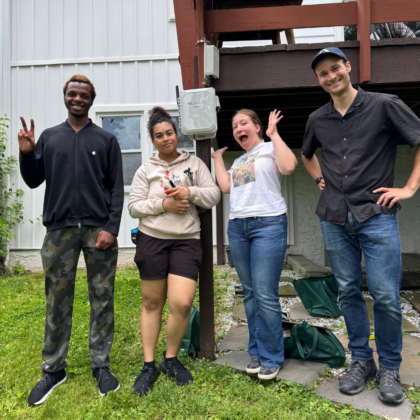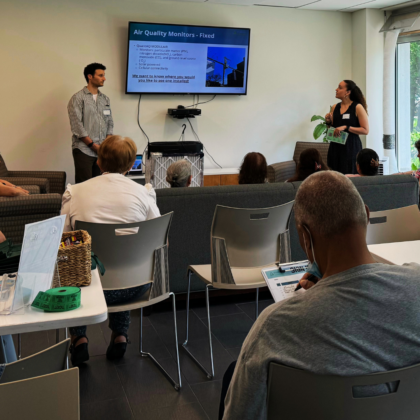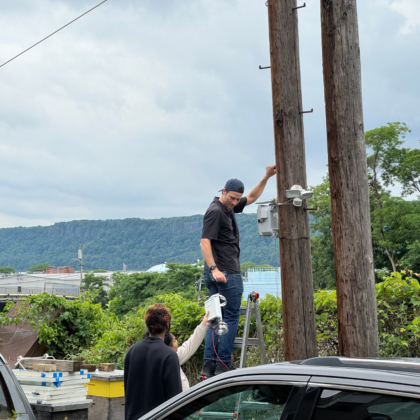In the heart of Yonkers, NY, a small but mighty team at Groundwork Hudson Valley is turning data into action–one air quality sensor at a time.
Groundwork Hudson Valley’s newest air quality campaign, Know Your Air, is an initiative centering hyper-local air quality in data to shift how the community understands and addresses air pollution. Unlike broad regional data, this campaign zeroes in on neighborhood-specific air quality to protect sensitive groups from the hidden dangers of pollution.
In this interview, Candida Rodriguez and Harrison Nesbit from Groundwork Hudson Valley talk about how they work with residents to not only understand air quality data but also act on it.
Q: What’s the driving force behind the Know Your Air campaign, and what are you aiming to achieve?
Harrison: Yonkers as a whole usually has decent air quality, but that is not universal. In addition to the highways that bisect the city and industrial factories that increase air pollutants, extreme heat is a real issue here, largely due to an abundance of impermeable surfaces and insufficient tree canopy, especially in formerly redlined areas. Extreme heat also impacts their air quality because particulates don’t get blown away easily, and the presence of sunlight allows for some pollutants to go through a chemical transformation and become more harmful to our health. During heat waves, when the air quality is poor, studies show that there is an amplifying effect resulting in a 21% higher risk of death for sensitive groups like the elderly, children, and those with preexisting conditions. Even more, the air quality info we get on our phones is not good enough; it only covers broad regions, not specific neighborhoods.
We decided to launch the Know Your Air campaign to collect block-to-block data on air quality disparities, especially in redlined areas. These efforts also build on our Climate Safe Neighborhoods initiative, where we link past housing discrimination to climate change, and work with residents to find out what climate resilience looks like for them.

Q: Could you highlight some of the strategies you’re using in the campaign?
Harrison: The Know Your Air campaign focuses on two main pillars that work together. One pillar focuses on community-based air quality monitoring. This means identifying and tackling pollution issues that affect community health directly. Regional monitors often miss what’s really going on in specific areas, especially in redlined neighborhoods. With community-based monitoring, we can see the air quality data that disproportionately impacts residents on a hyper-local level and find targeted solutions.
The next pillar is education and outreach. We want to know what residents are worried about and experiencing when it comes to air quality. We also teach them how to monitor air quality, how to check the air quality index, and how to reduce risks on bad air days.
Q: How do you get the community excited and involved with the campaign?
Harrison: Most of this program is focused on capacity building to enhance skills and knowledge around air quality. The Climate Safe Yonkers Task Force, a coalition of local community members committed to championing climate resilience, meets quarterly to plan outreach and events. The Task Force has two working groups: one on air quality and another on enhancing the urban tree canopy. The working groups are coming up with their own outreach plan. For instance, one resident on the air quality working group is going to host a Spanish-speaking event at the Yonkers Public Library where she’s going to bring in two doctors from a local hospital to speak about the short and long-term impacts of air quality.
Candida: Having community members lead these events has a bigger impact and reach due to their existing local connections which helps us tap into new community members that maybe we haven’t been able to in the past. We’re also ensuring our Task Force members are continuously building their capacities and have agency over the issues they are working to address.
Additionally, we’re extending our outreach to municipal and affordable housing properties, where we already have established relationships. We attend tenant council meetings to deliver short, impactful presentations on air quality, air pollution and how it affects you, what you can do to stay safe, and how to check the air quality index.

Q: Have there been any standout moments or big wins in the campaign that you’d like to share?
Candida: It’s great to see folks truly getting to know their neighborhoods and grasping local environmental issues! Many residents are now able to make the connection between really hot days and when their allergies get worse and put words to their experiences that they might not have known before. After one of our presentations, one woman was so excited about using her air purifier which she kept in a corner because she wasn’t sure what it was for!
We’ve also expanded our reach by introducing outreach materials in both English and Spanish that discuss air quality. During presentations, we deliver it in English and Spanish and it’s been great seeing how we can talk to more people about these issues and how to stay safe.
Q: What tips or precautions do you suggest to the community on days when the air quality isn’t the best?
Firstly, if you belong to a sensitive group, it’s crucial to monitor the Air Quality Index (AQI) regularly. An AQI reading above 100 means you should take certain precautions if you’re in a sensitive group, while a reading over 150 is unhealthy for everyone. When air quality declines, consider taking these precautions:

- Reduce strenuous exercise outdoors.
- If possible, keep windows closed to reduce exposure to pollutants.
- Regularly clean your air conditioning filters.
- If you have one, turn on your air purifiers, especially on hot days. Or watch this video to learn how to make your own!
- Refrain from using gas stoves as the pollutants they emit can accumulate in enclosed spaces.
- Reduce the use of fragrances in your home such as sprays, plugins, and incense.
- Wear masks outdoors, particularly if you’re part of a sensitive group.
Q: What are some lessons or takeaways from running the Know Your Air campaign so far?
Candida: First off, we should keep things positive—scaring people doesn’t help. We focus on ensuring people know they have agency and that they can reduce personal risk and trust the data and science. Also, it’s important to make sure your messaging is accessible and easily understood by a diverse audience, as air quality issues can be complex. Lastly, it’s crucial to have a deep understanding of local conditions and climate issues, from traffic jams and factories to other pollution sources, so you can connect with the folks who are truly affected.
The fight against air pollution is far from over, but with community-based efforts like those spearheaded by Groundwork Hudson Valley, we’re making strides. By engaging locals through workshops, and centering them in the mission, they’ve created a movement that’s focused on change where it matters most—in the heart of impacted communities. And it’s just getting started!
Learn more about their community science efforts and follow along through their Air Quality Initiatives page.
